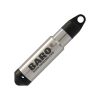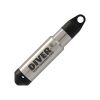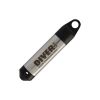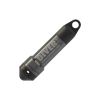Van Essen Diver Smart Interface Cable
Features
- Real-time atmospheric pressure measurement
- Informational indicators: ready, sending data, receiving data
- Warning indicators: Diver not connected/communicating, cable malfunctioning
- Free ground shipping
- Expedited repair and warranty service
- Lifetime technical support
- More
Overview
The Van Essen Diver Smart Interface Cable is a communication device to link the Divers deployed on a communication cable (DXT or DDC) to a PC, laptop and/or tablet. Simply plug the Smart Interface Cable in an available USB port of the computer and connect the other end to the communication cable. The deployed Diver can now be accessed using the free Diver-Office software. Once connected, the Diver can be programmed, settings read, or data downloaded.
Design
The Smart Interface Cable features a barometric sensor that allows for real-time comparison of Diver readings and manual measurements. After connecting the Smart Interface Cable, the Diver can be returned to its original position in the well with the supplied Suspension Plate. The Smart Interface Cable features indicators for sensing if a cable is connected, a Diver is connected to the communication cable or if the communication cable is malfunctioning.
Applications
The Smart Interface Cable can be used for communication cables from 1 meter up to 500 meters in length. The Smart Interface Cable is designed to be used in the field and supports all Divers.
Note: Diver-Office 2017.2 or later must be installed to be able to communicate to the Diver through the Diver Smart Interface Cable.
- (1) Diver Smart Interface Cable
- (1) Suspension plate
In The News
Three Decades of Research at Acton Lake
A multi-disciplinary team at Miami University, Ohio, has been studying the environmental change at Acton Lake for over three decades. Using three different NexSens buoys over this time, the team has an incredible archive of data that is helping build a picture of Acton’s past, present, and future. Until recently, a NexSens CB-50 buoy was used alongside other environmental monitoring at Acton Lake. In May 2025, the Miami team deployed a new XB-200 buoy , future-proofing their ongoing monitoring using real-time buoy systems. Acton Lake, a small hypereutrophic reservoir in southwest Ohio, covers 2.4km² and has a maximum depth of about 8m. The dam was built in 1956, and the lake has a large agricultural watershed.
Read MoreSource Water Monitoring in Albany, New York: Tracing Water Quality throughout Tributaries
Thousands of US cities pull their drinking water from natural source waters like reservoirs, rivers, and streams, making overall watershed health a key consideration for water providers. In Albany, New York, the Albany Department of Water and Water Supply delivers drinking water to over 100,000 residents as well as monitors and manages the larger drinking water supply watershed. Hannah Doherty, Environmental Specialist at the Albany Department of Water and Water Supply , spends her days working with a small team to monitor the drinking supply and the connected water bodies. Doherty explains, “We’re the first to encounter the water that ends up being the drinking water.
Read MoreWildfire Prevention in the Sierra Nevada Region with the Yuba Watershed Institute
Though recent wildfires have sparked new conversations about wildfire management and response, groups like the Yuba Watershed Institute have been monitoring the forests and water resources of the Sierra Nevada region for decades, managing approximately 5,000 acres of land with the Bureau of Land Management (BLM) and about 7,000 acres in private land partnerships. The goal of the Institute is to work with local communities and land agencies to improve watershed and forestry management through informed practices and public outreach. The goals of the Yuba Watershed Institute are three-fold: Improve the ability of fire suppression agencies like the California Department of Forestry and Fire Protection ( CAL FIRE ) and the US Forest Service.
Read More













